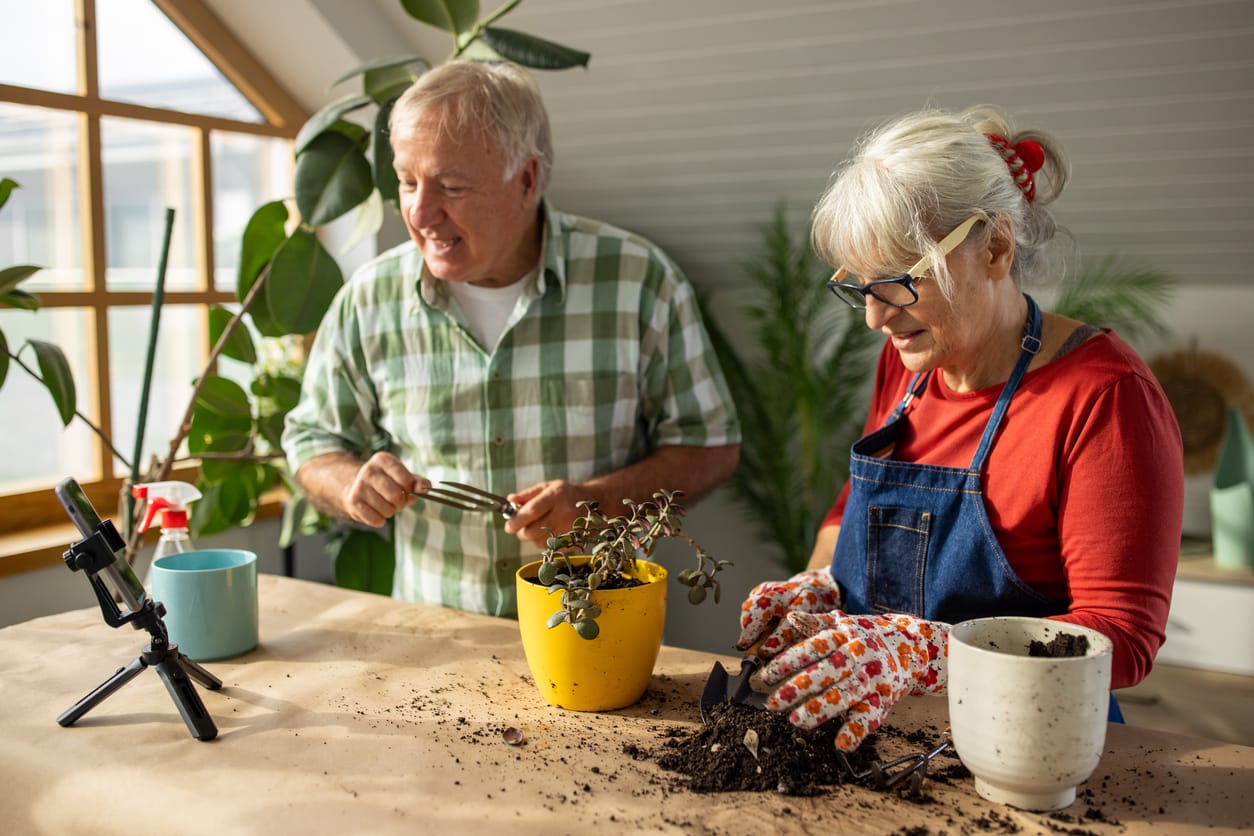Gardening holds a cherished place in the hearts of many seniors, offering not only a beloved hobby but also a therapeutic refuge for nurturing physical and mental well-being. As family caregivers, we recognize the importance of harnessing the benefits of gardening tips while prioritizing safety and comfort through ergonomic tools and techniques. By facilitating access to lightweight, easy-to-use gardening implements and promoting proper techniques such as pacing and taking breaks, we empower our elderly loved ones to enjoy the physical exercise, emotional fulfillment, and sense of purpose that gardening provides. Through these efforts, we not only cultivate vibrant gardens but also cultivate joy, health, and harmony in the lives of our cherished seniors.
Why Ergonomics Matter in Gardening
Navigating the joys of gardening in older age presents unique challenges for seniors and their caregivers alike. As we strive to ensure the well-being and enjoyment of our elderly loved ones, understanding and integrating the concept of ergonomics in the context of gardening becomes paramount. Ergonomics, the science of designing tools and methods to promote efficiency and comfort while reducing strain on the body, holds particular significance in facilitating a safe and fulfilling gardening experience for seniors.
Challenges
- Reduced mobility: Seniors may experience limitations in movement due to conditions such as arthritis or general age-related decline.
- Arthritis: Joint pain and stiffness can make gripping and using traditional gardening tools difficult and uncomfortable.
- Back pain: Chronic back issues can be exacerbated by bending or kneeling during gardening tasks, leading to discomfort and reduced mobility.
By recognizing and actively addressing these challenges through ergonomic interventions, caregivers can empower their elderly relatives to continue enjoying the therapeutic benefits of gardening while minimizing discomfort and strain. Through thoughtful consideration and implementation of ergonomic principles, we pave the way for our loved ones to nurture their connection with nature, cultivate vibrant gardens, and thrive in their golden years.
Ergonomic Tools for Senior Gardeners
Ensuring the safety and comfort of our elderly loved ones during their gardening endeavors is paramount. By carefully selecting and modifying gardening tools, we can empower seniors to pursue their passion for gardening with ease and enjoyment. Here are some practical suggestions for incorporating ergonomic tools into their gardening routine:
Tool Selection
Recommend tools crafted from lightweight materials such as carbon fiber or aluminum. These materials reduce the overall weight of the tool, making them easier to handle for seniors with limited strength or mobility.
Suggest tools with longer handles to prevent excessive bending and reaching, which can strain the back and joints. Longer handles provide greater leverage and minimize the need for strenuous movements.
Tool Modifications
Discuss adaptations such as adding foam grips or handles to tools. These modifications improve grip comfort and reduce the strength required to hold onto the tool, especially beneficial for seniors with arthritis or reduced hand strength.
Highlight specialized tools designed for arthritis sufferers, such as ratchet-style pruners or ergonomically designed shovels. These tools feature innovative designs that alleviate stress on arthritic joints, allowing seniors to garden with greater ease and comfort.
Gardening Accessories
Suggest the use of a garden kneeler with handles or a gardening seat. These accessories provide support and cushioning, minimizing strain on the knees and back during prolonged periods of kneeling or bending.
Recommend garden carts or wheelbarrows with easy-load features and stable wheels. These tools simplify the transportation of gardening supplies and heavy loads, reducing the risk of injury from lifting or carrying cumbersome objects.
By incorporating ergonomic tools and accessories into their gardening routine, seniors can continue to cultivate their passion for gardening while maintaining their physical well-being. Let us empower our elderly loved ones to enjoy the therapeutic benefits of gardening for years to come.
Safe Gardening Techniques for Seniors
Caring for our elderly loved ones involves ensuring their safety and well-being in every aspect of their lives, including their beloved gardening activities. Here are some essential safe gardening techniques to help seniors enjoy their time in the garden without risking injury or strain:
Proper Posture and Movements
- Offer guidance on maintaining good posture while gardening, emphasizing the importance of bending at the knees instead of the waist when lifting heavy objects or bending down to tend to plants. This technique reduces strain on the back and minimizes the risk of injury.
- Provide tips for utilizing the strength of one's legs and arms for digging or raking, rather than relying solely on the back muscles. By distributing the workload across different muscle groups, seniors can prevent muscle fatigue and strain.
Workload Management
- Advise on breaking gardening tasks into shorter segments to avoid overexertion and fatigue. Encouraging seniors to pace themselves and take breaks between tasks ensures they can enjoy gardening activities without feeling overwhelmed.
- Recommend scheduling gardening activities during the cooler parts of the day to avoid exposure to excessive heat. Gardening in the early morning or late afternoon helps reduce the risk of heat exhaustion and dehydration, particularly during warmer months.
Stretching and Breaks
- Encourage seniors to incorporate regular stretching exercises into their gardening routine to keep muscles flexible and prevent injuries. Simple stretches for the arms, legs, and back can help reduce stiffness and improve mobility.
- Stress the importance of taking frequent breaks to rest and hydrate, especially on warmer days. Remind seniors to listen to their bodies and pause for a drink of water or a brief rest to prevent fatigue and overheating.
By implementing these safe gardening techniques, family caregivers can support their elderly loved ones in enjoying the physical and mental benefits of gardening while minimizing the risk of injury or strain. Let us ensure that our seniors can continue to find joy and fulfillment in their gardening pursuits for years to come.
Creating an Ergonomic Garden Space for Seniors
As family caregivers, we understand the importance of creating a safe and comfortable environment for our elderly loved ones to enjoy their gardening activities. Here are some practical design tips for establishing an ergonomic garden space tailored to their needs:
Consider Raised Beds or Vertical Gardening
Suggest incorporating raised beds or vertical gardening structures into the garden layout to minimize the need for stooping or bending. Raised beds elevate planting areas to a more accessible height, reducing strain on the back and knees when tending to plants. Vertical gardening, such as trellises or wall-mounted planters, maximizes space and accessibility, allowing seniors to tend to their plants without having to bend down or reach overhead.
Design Accessible Paths
Discuss the importance of pathways that allow easy access and mobility throughout the garden. Wide, level pathways made of smooth materials such as gravel or paving stones facilitate movement for individuals with mobility aids such as walkers or wheelchairs. Ensure that pathways are free from obstacles and have sufficient lighting for safe navigation, particularly during evening hours. Additionally, consider incorporating seating areas along the pathways to provide opportunities for seniors to rest and admire their garden.
By implementing these design tips for an ergonomic garden space, caregivers can create a safe and enjoyable environment where their elderly loved ones can continue to indulge in their passion for gardening. Let us strive to cultivate a space that promotes independence, mobility, and overall well-being for our seniors as they nurture their connection with nature.
Resources for Senior Gardeners
As family caregivers, we recognize the importance of supporting our elderly loved ones in their gardening pursuits by providing access to resources tailored to their needs. Here are some valuable resources for senior gardeners to explore:
Online Retailers for Ergonomic Tools: Direct seniors to online retailers that specialize in ergonomic gardening tools, making it easier for them to find products designed specifically for their comfort and safety. Websites such as Gardener's Supply Company, Radius Garden, and The Wright Stuff offer a variety of ergonomic gardening tools, including lightweight implements with extended handles and easy-grip designs.
Local Community Groups and Organizations: Highlight organizations or local community groups that focus on senior gardening activities, where seniors can seek advice, share experiences, and connect with like-minded individuals. Community gardens, senior centers, and gardening clubs often host workshops, classes, and social events tailored to the needs and interests of senior gardeners. Encourage seniors to reach out to these organizations to learn more about available resources and opportunities for participation.
In summary, the integration of ergonomic tools and techniques in gardening is vital for seniors to maintain an active lifestyle safely. By emphasizing ergonomics, seniors can engage in gardening activities without risking strain or injury, thus continuing to enjoy the physical activity and mental benefits it offers. It's imperative for both caregivers and seniors to approach gardening with the right tools and mindset, ensuring they can fully appreciate its rewards while safeguarding their health. As we conclude, I encourage readers to share their own experiences and tips for ergonomic gardening, fostering a supportive community where seniors can thrive in their gardening pursuits while aging gracefully.





